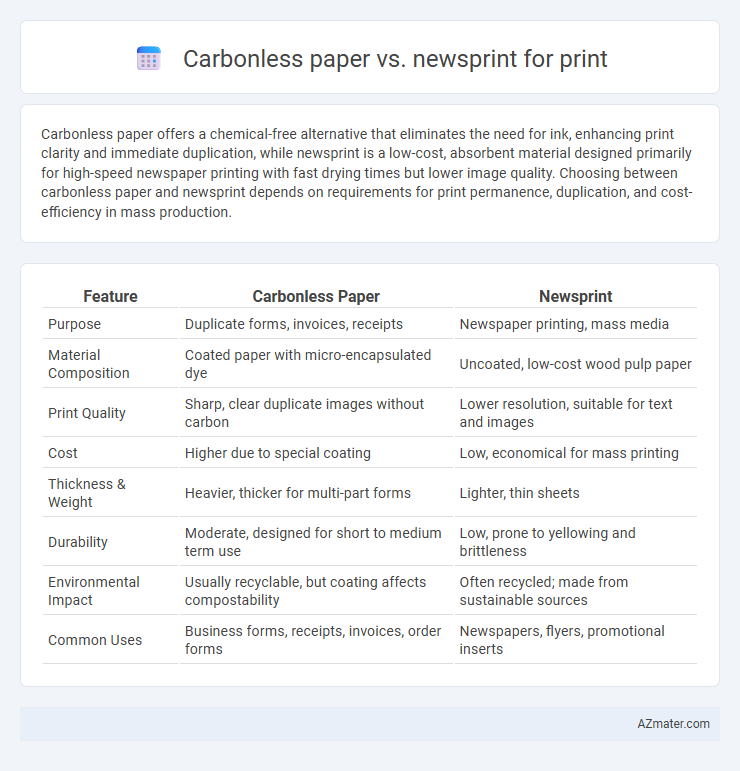Carbonless paper offers a chemical-free alternative that eliminates the need for ink, enhancing print clarity and immediate duplication, while newsprint is a low-cost, absorbent material designed primarily for high-speed newspaper printing with fast drying times but lower image quality. Choosing between carbonless paper and newsprint depends on requirements for print permanence, duplication, and cost-efficiency in mass production.
Table of Comparison
| Feature | Carbonless Paper | Newsprint |
|---|---|---|
| Purpose | Duplicate forms, invoices, receipts | Newspaper printing, mass media |
| Material Composition | Coated paper with micro-encapsulated dye | Uncoated, low-cost wood pulp paper |
| Print Quality | Sharp, clear duplicate images without carbon | Lower resolution, suitable for text and images |
| Cost | Higher due to special coating | Low, economical for mass printing |
| Thickness & Weight | Heavier, thicker for multi-part forms | Lighter, thin sheets |
| Durability | Moderate, designed for short to medium term use | Low, prone to yellowing and brittleness |
| Environmental Impact | Usually recyclable, but coating affects compostability | Often recycled; made from sustainable sources |
| Common Uses | Business forms, receipts, invoices, order forms | Newspapers, flyers, promotional inserts |
Introduction to Carbonless Paper and Newsprint
Carbonless paper, also known as NCR (No Carbon Required) paper, is designed for creating instant duplicate copies without the need for carbon sheets, commonly used in invoices and receipts. Newsprint is a low-cost, lightweight paper primarily used for printing newspapers, characterized by its high opacity and low brightness. The key difference lies in carbonless paper's chemical coating that enables copy transfer, whereas newsprint focuses on affordability and quick drying for mass print runs.
Composition and Manufacturing Processes
Carbonless paper consists of micro-encapsulated dye or ink on the back of the top sheet and a clay coating on the front of the bottom sheet, facilitating image transfer without carbon sheets. Its manufacturing process involves coating layers with reactive chemicals that react under pressure to produce duplicate copies instantly. Newsprint, primarily composed of mechanical wood pulp, undergoes a simpler manufacturing process involving pulping, pressing, and drying, designed for high-speed, low-cost production with less emphasis on transfer coatings.
Primary Uses and Applications
Carbonless paper is primarily used for creating multi-part forms, invoices, and receipts where duplicate copies are needed without the use of carbon sheets. Newsprint is mainly utilized for printing newspapers, flyers, and inexpensive promotional materials due to its low cost and high absorbency. Each type serves distinct applications based on print durability and cost-efficiency requirements.
Print Quality and Image Clarity
Carbonless paper offers superior print quality and image clarity compared to newsprint, as it is specifically designed for clean, sharp transfers without smudging or bleeding. The micro-encapsulated dye and reactive clay coatings on carbonless paper ensure crisp, clear images ideal for multi-part forms and invoices. In contrast, newsprint's porous texture and low brightness result in lower image resolution and duller print quality, making it less suitable for detailed or high-quality printing.
Durability and Longevity
Carbonless paper offers superior durability and longevity compared to newsprint, resisting yellowing and tearing over extended periods due to its chemical coating. Newsprint, primarily made from low-cost wood pulp, tends to degrade quickly, becoming brittle and discolored within months under environmental exposure. For archival and long-term documentation purposes, carbonless paper maintains integrity and legibility far longer than newsprint.
Environmental Impact and Sustainability
Carbonless paper contains chemical coatings that can introduce harmful substances into the environment, making its disposal and recycling more challenging compared to newsprint, which is primarily made from recycled wood fibers. Newsprint is typically more sustainable due to its higher recyclability and lower chemical content, and it often utilizes renewable resources and less water during production. Choosing newsprint can significantly reduce carbon footprint and landfill waste, aligning better with eco-friendly printing practices.
Cost Comparison and Affordability
Carbonless paper typically costs more due to its specialized coating designed for duplicate and triplicate forms, whereas newsprint is significantly cheaper as it is produced for mass printing of newspapers and flyers. Affordability considerations favor newsprint for high-volume, low-cost printing applications, while carbonless paper offers value in contexts requiring multi-part forms without added copying equipment. Businesses must weigh the upfront cost differences against functional benefits when choosing between carbonless paper and newsprint for print projects.
Compatibility with Printing Equipment
Carbonless paper requires specialized printing equipment such as impact or dot matrix printers to transfer micro-encapsulated dye for clear image reproduction, making it less compatible with standard inkjet or laser printers. Newsprint is highly compatible with conventional offset and flexographic presses, designed for high-speed, large-volume printing with absorbent qualities to quickly dry ink. Selecting the appropriate paper depends on the printing technology used and the desired output quality.
Advantages and Disadvantages of Each
Carbonless paper offers the advantage of creating instant duplicates without the need for carbon sheets, making it ideal for multi-part forms and invoices; however, it is generally more expensive and less environmentally friendly than newsprint. Newsprint is cost-effective and recyclable, commonly used for newspapers and flyers, but it lacks the ability to produce multi-copy documents and has lower print quality and durability compared to carbonless paper. The choice between carbonless paper and newsprint depends on the specific printing needs, prioritizing either multi-part functionality or budget and sustainability considerations.
Choosing the Right Paper for Your Printing Needs
Carbonless paper offers high-quality, smudge-free duplicate copies ideal for multi-part forms, while newsprint is an economical choice primarily used for mass print runs like newspapers with lower-quality image retention. Selecting the right paper depends on print durability, cost-effectiveness, and the necessity for clear, instant duplicates versus bulk distribution. Businesses requiring sharp, carbonless copies should prioritize chemical-coated paper, whereas large-scale publications benefit from lightweight, absorbent newsprint.

Infographic: Carbonless paper vs Newsprint for Print
 azmater.com
azmater.com